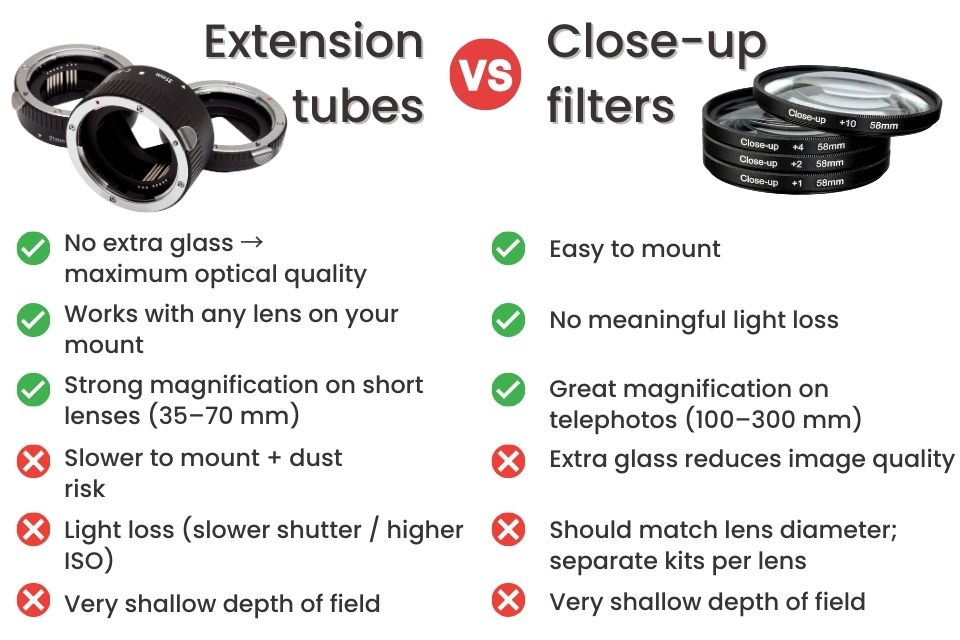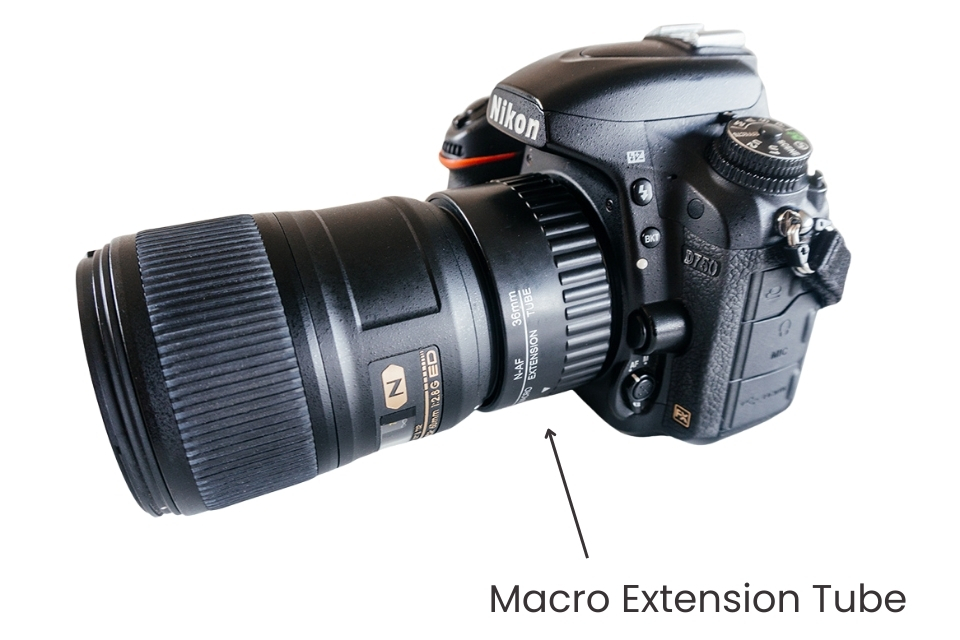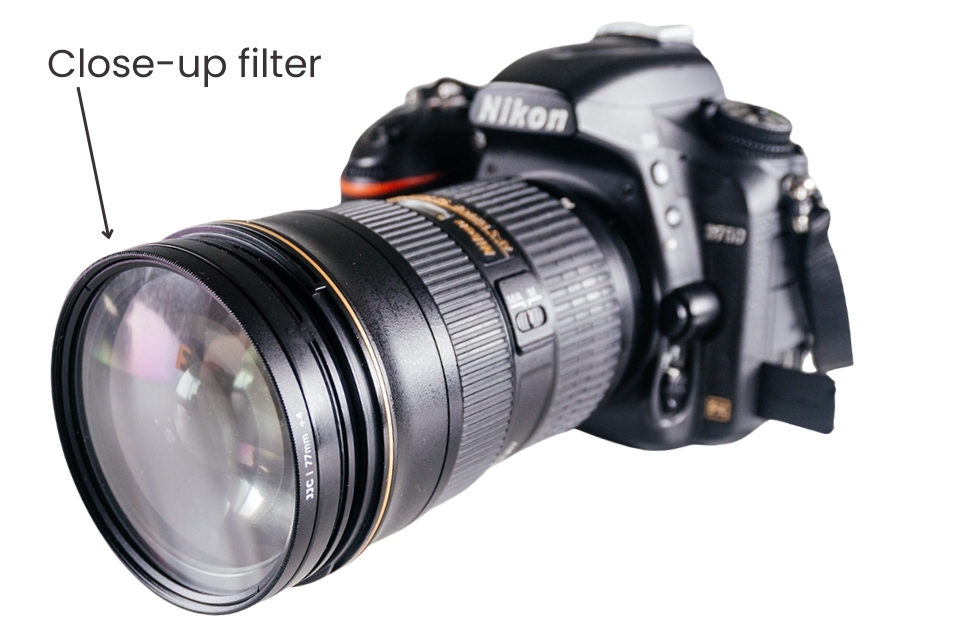Macro photography doesn’t have to start with an expensive dedicated macro lens. Two budget-friendly ways to get close are extension tubes and close-up filters (diopters). Both let your existing lenses focus closer; they just do it differently. Here’s a short side-by-side comparison.
 Beginner Macro: Extension Tubes vs Close-Up Filters
Beginner Macro: Extension Tubes vs Close-Up Filters
Now let’s look in more detail at extension tubes and close-up filters—their benefits, trade-offs, and when to use each.
Extension Tubes
Think of a spacer. You put a hollow tube between camera and lens. This lets the lens focus closer(no optics inside).
 Beginner Macro: Extension Tubes
Beginner Macro: Extension Tubes
Pros
- No extra glass → best optical integrity (sharpness/contrast limited only by your lens).
- Mount-wide compatibility: One set works with all lenses on your DSLR mount.
- Strong magnification on short lenses: Effect ≈ extension length ÷ focal length.
- Modular: Stack 12/20/36 mm, etc., to dial in magnification.
- Front of lens stays free for hoods, polarizers, ring flashes, diffusers.
- Excellent for tabletop/product/coins where light and stability are controlled.
Cons
- Light loss: Effective aperture increases with extension → darker viewfinder, slower shutter / higher ISO.
- Very shallow depth of field at high magnification; often need to stop down.
- Short working distance on shorter lenses (sometimes just a few cm).
- Less effective on telephotos: A 20–30 mm tube adds only modest magnification at 200 mm.
- Slower to use: You must unmount the lens to attach/remove; be mindful of dust.
- Cheap tubes without contacts: Lose electronic aperture control/AF on modern lenses.
- No infinity focus while tubes are attached.
Beginner tip: Get a set with electronic contacts (often 12/20/36 mm). You keep aperture control and (sometimes) AF, and you can stack to taste.
What Are Close-Up Filters (Diopters)?
Think of a small magnifying glass. It screws onto your lens like any filter. Common strengths: +1, +2, +4, +8, +10 (diopters).
 Beginner Macro: Close-Up Filters
Beginner Macro: Close-Up Filters
Pros
- Super quick: Screw on/off in seconds. No lens removal.
- No meaningful light loss: Easier hand-held shutter speeds.
- Great on telephotos (100–300 mm): Bigger magnification gains than tubes, with more working distance.
- Keep AF and aperture control as usual.
- Compact & inexpensive entry: Cheap sets exist; step-rings let one size fit many lenses.
- Also usable on fixed-lens cameras that have filter threads.
Cons
- Adds glass: Potential edge softness, contrast loss, and chromatic aberration—especially with cheap single-element or strong (+8/+10) filters.
Tip: Achromatic two-element diopters greatly improve quality but cost more. - Thread-size dependent: Need correct diameter or step-up rings; very large sizes can be pricey/hard to find.
- Edge/corner softness & field curvature: Noticeable on flat copywork (stamps/documents).
- Narrow focus range at high power: The “in-focus window” can be tight.
- Stacking risks: More aberrations and possible vignetting.
- Blocks front threads: Limits simultaneous use of other filters/hoods (unless the diopter has front threads).
- No infinity focus while attached.
Quick Guidance
- Insects / skittish wildlife outdoors: Close-up filter on a tele-zoom for working distance + hand-held shutter speeds.
- Flowers on a walk / fast switching: Close-up filter (speed and convenience).
- Coins, jewelry, miniatures (tripod): Extension tubes (maximum detail, no added glass).
- Short primes & kit zooms (35–70 mm): Tubes give stronger magnification.
- Tele-zooms (100–300 mm): Close-up filters typically outperform tubes for magnification and distance.
Final Thoughts
Want macro on a budget? Extension tubes and close-up filters are perfect starters. They let you practice the fundamentals first, then decide if a macro lens is worth it.
My workflow note: I keep one or two close-up filters in my pocket for outdoor walks (they go on in seconds). I save extension tubes for the home studio, where I can mount them carefully, avoid dust, and use a tripod. This combo covers almost everything for very little money. This mix covers most situations for very little money—and helps you discover what kind of macro shooting you enjoy most.
👉 In my next post, we continue the extension tubes vs close-up filters comparison with side-by-side image examples and practical tips.